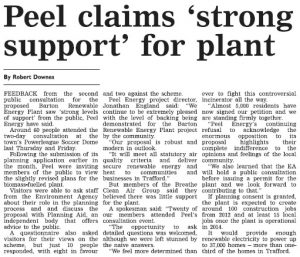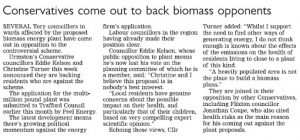Local Press Releases
The Breathe Clean Air Group have featured in three local press articles this week. Â Following Peel Energy’s Consultation last week, Peel stated that there were, “strong levels of support,” for the plant and that, “80% of attendees who provided feedback said that they strongly agreed with the proposal.” Â However, on investigation of the figures used to determine these bold statements, it was found that this was based on the feedback from only 10 people. Â Given that we have paper and online petition signatures from 5000 people, Peel Energy appear to show a complete disregard of local opinions and instead, prefer more focused on trying to use ploys to sell the proposal to us. Â No thank you!
Also, the strengthening support from our local councillors has also been fantastic news. Â We are extremely pleased to hear they have evaluated the evidence and are supporting us. Â Many councillors are signing our petition too.
Read the articles to find out more!




Will the Environment Agency or Peel Holdings make any comment on the following article and letter in Monmouthshire Beacon, 16 Dec 2010?
Residents vent their fears
Thursday, 16 December 2010
Plans for an incinerator on Hadnock Road came under scrutiny last week at a public meeting held in the Shire Hall. ?Chaired by Liz Hacket-Pain, residents heard from three speakers who were able to talk with some authority and experience on the subject. ?George Boyce, a resident who retired from the chemical industry and has been involved with environmental management systems, explained the pyrolysis process and how it would affect the immediate area. ?Using waste wood and organic matter to provide electricity, he explained, has many drawbacks, not only in the delivery of an estimated 145 tonnes per day of wood, but in the emmission of gasses and contaminated water waste that the process creates. ?Elements of lead, chromium, copper and arsenic would end up in the ash, a residue from the waste wood of which pallets are a prime source, which he said would be marketed as a soil improver. ?Peter Bere, an expert in renewable resources since the late 1960s, spoke of how planning authorities are under pressure to give the green light to processes such as this following European Council targets for renewable energy. ?A more suitable system would be a micro hydro-power system on the River Wye, close to the bridge. ?Finally, Dr Dick van Steenis MBBS then explained why he was opposed to the application, stating that it was the wrong technology in the wrong place (see letters, page six). ?Opening the meeting up to the floor, residents then had ample opportunity to express their fears and criticised the plans for being too vague. ?Disappointed that the applicant did not attend, nor anyone from the planning department or the Environment Agency, they expressed their objections to such a proposal given the road was well known for its flooding problems and considering the waste water that the factory would create. ?The area was well known for its beauty and its fishing and the road is used by cyclists and school pupils every day. ?Closing the meeting, Liz Hacket-Pain said there was much to take forward to future meetings and it woud be a good opportunity to contact the Planning Department for more information. ?Speaking to the Beacon after the meeting, she said the meeting went well, with some very good concerns raised and valid points brought into the open.
http://www.monmouth-today.co.uk/News.cfm?id=44164&headline=Residents%20vent%20their%20fears
Opposed to wood burning plant
Wednesday, 15 December 2010
SIR, ?With reference to the proposed wood burning plant (planning ref DC/2010/00658) on Hadnock Road. ?I oppose the application as it is not the best available technique and a health hazard to inhabitants of greater Monmouth. ?Wood burning and burning red diesel create almost entirely PM1-size particulates plus some PM2.5s containing polycyclic aromatic hydrocarbons (PAHs). ?This size is not regulated in the UK. ?The Environment Agency wrote this year that 90 per cent of PM1s and 35 per cent of PM2.5s escape through UK bag filters, if fitted. ?PM1s are the worst possible size particulate for adults and children to inhale. ?This was known in the USA in 1943, yet is still ignored in the UK. ?A recent study in Austria published in a journal proved PM1s are even worse than PM2.5s for damaging children’s lungs. ?PAHs cause low birth weight babies, lower IQ in direct proportion to concentrations, cause asthma, heart attacks and contribute to cancers. ?PM1s and PM2.5s cause asthma, COPD, heart attacks, compromised immune systems and clinical depression at least, and any heavy metals present could cause diabetes type two and further cancers as well. ?The best available technique for a wood-fired power station is plasma gasification, using an electric welding arc. ?The emissions are safe, and three times the electricity is produced compared with incinerator/ combined heat and power units. ?Some four times the electricity is produced compared with what is used. ?These units have been built in USA, Canada, France, Puerto Rico and elsewhere and are now also being built in Russia and China. ?The syngas formed can alternatively be treated to produce petrol or diesel fuel in a scaled system as is happening in Canada, UAE and USA. ?If a plasma gasification unit was built instead, Monmouth could add much of its residual and/ or commercial or hazardous waste to waste wood for safe treatment to produce green electricity safely. ?Dr Dick van Steenis ?(Monmouth)
http://www.monmouth-today.co.uk/Letters.cfm?id=43987&headline=Opposed%20to%20wood%20burning%20plant